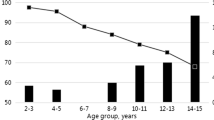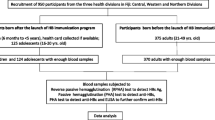Abstract
The implementation of the Expanded Program of Immunization (EPI) in 1989 has dramatic impact on hepatitis B virus (HBV) infection in school children in Malaysia. A cross-sectional seroprevalence study of HBV infection in 190,077 school children aged 7–12 years from 1997 to 2003 showed a steady decline of HBV surfacce antigen (HBsAg) prevalence rate from 2.5% for children born in 1985 to 0.4% among school children born in 1996. The overall prevalence of HBsAg was 0.6%, 0.7% in males and 0.6% in females. Over 92.7% of school children had been vaccinated with HBV vaccine, in which 93.7% were vaccinated under the EPI and 6.3% on voluntary basis. The school children vaccinated under EPI had a 0.4% HBsAg carrier rate, which was significantly lower than school children vaccinated on a voluntary basis (HBsAg carrier rate 1.3%) and non-vaccinated school children (HBsAg carrier rate 2.7%), suggesting that HBV vaccination of infants was the most effective measure in preventing vertical transmission of HBV in the hyperendemic region.
Similar content being viewed by others
References
Gust ID (1996) Epidemiology of hepatitis B infection in the Western Pacific and South East Asia. Gut 38 (Suppl 2):S18–S23
Campbell DH, Plant AJ, Sargent JW, Mock PA, et al (1991) Hepatitis B infection of children in a mixed-race community in western New South Wales. Med J Aust 154:253–256
Guan R (1996) Hepatitis B virus infection in Singapore. Gut 38 (Suppl 2):S13–S17
Ton SH, Lopez CG, Cheong KS, Noriah R (1984) Infectiousness with respect to HBV of medical staff and patients in the General Hospital, Kuala Lumpur. Singapore Med J 25:244–246
Lopez CG (1985) Epidemiology of persistent hepatitis B virus infection. Malaysian J Pathol 7:7–10
Beasley RP, Hwang LY (1983) Postnatal infectivity of hepatitis B surface antigen-carrier mothers. J Infect Dis 143:185–190
Stevens CE, Neurath RA, Beasley RP, et al (1979) HBeAg and anti-HBs detection by radioimmunoassay. Correlation with vertical transmission of hepatitis B in Taiwan. J Med Virol 3:237–241
Margolis HS (1990) The road ahead—future policy for the elimination of hepatitis B transmission in the United States. Proceeding of the 24th National Immunization Conference. US Department of Health and Human Services, Washington D.C., pp 33–37
Wong VCW, Ip HMH, Reesink HW, Lelie PN, Reerink-Brongers EE, et al (1984) Prevention of HBsAg carrier state in newborn infants of mothers who are chronic carriers of HBsAg and HBeAg by administration of hepatitis B vaccine and hepatitis B immunoglobulin. Lancet I:921–926
Goh KT (1995) Acute hepatitis B survillance in Singapore. Epidemiol News Bull 21:33–34
Tsen YJ, Chang MN, Hsu HY Y, et al (1991) Seroprevalence of hepatitis B infection in children in Taipei 1989: five years after a mass hepatitis B vaccination programme. J Med Virol 34:96–99
Chen DS, Sung JL, Lai MY (1978) A seroepidemiological study of hepatitis B infection in Taiwan. J Formosa Med Assoc 77:908–918
Beasley RP, Hwang LY, Lin CC, Leu ML, Stevens CE, et al (1982) Incidence of hepatitis B virus infections in preschool children in Taiwan. J Infect Dis 146:198–204
Szmuness W, Harley EJ, Ikram H, Stevens CE (1978) Sociodemographic aspects of the epidemiology of hepatitis B. In: Vyas GN, Cohen SN, Schmid R (eds) Viral hepatitis: a contemporary assessment of etiology, epidemiology, pathogenesis and prevention. Franklin Institute Press, Philadelphia, pp 297–320
Vann Mayans M, Hall AJ, Inskip HM, et al (1990) Risk factors for transmission of hepatitis B virus to Gambian children. Lancet 336:1107–1109
Gust ID, Dimitrakakis M, Zimmet P (1978) Studies of hepatitis B surface antigen and antibody in Nauru. I. Distribution among Nauruans. Am J Trop Med Hyg 27:1030–1036
Milne A, Allwood GK, Moyes CD, et al (1989) Prevalence of hepatitis B infections in a multiracial New Zealand community. N Z Med J 98:529–532
CDC (1988) Recommendations of the Immunization Practices Advisory Committee. Prevention of perinatal trasnsmission of hepatitis B virus. Prenatal screening of all pregnant women for hepatitis B surface antigen. MMWR 37:341–356
Margolis HS, Coleman PJ, Brown RE, Mast EE, et al (1995) Prevention of hepatitis B virus transmission by immunization. An economic analysis of current recommendations. JAMA 274:1201–1208
Author information
Authors and Affiliations
Corresponding author
Rights and permissions
About this article
Cite this article
Ng, K.P., Saw, T.L., Baki, A. et al. Impact of the Expanded Program of Immunization against hepatitis B infection in school children in Malaysia. Med Microbiol Immunol 194, 163–168 (2005). https://doi.org/10.1007/s00430-004-0231-4
Received:
Published:
Issue Date:
DOI: https://doi.org/10.1007/s00430-004-0231-4




